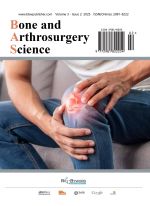Hemostatic Effects of Tranexamic Acid on Geriatric Total Hip Arthroplasty
Abstract
Objective: The aim of this paper was to investigate the hemostatic effect of tranexamic acid in elderly patients undergoing artificial hip arthroplasty. Methods: Ninety-six patients who underwent artificial hip replacement surgery from June 2023 to January 2025 were selected and divided into two groups of 48 cases each. Tranexamic acid was applied intraoperatively in the observation group, and hemostasis was performed by conventional methods in the control group. Intraoperative bleeding, postoperative bleeding, total blood loss, proportion of blood transfusion, hemoglobin, erythrocyte pressure volume, and other complications were compared between the two groups. Results: The intraoperative bleeding volume, postoperative drainage volume, and total blood loss in the observation group were significantly lower than those in the control group (P < 0.05), and the transfusion rate was also significantly lower than that in the control group (P < 0.05). Postoperatively, hemoglobin and erythrocyte pressure volume decreased less in the observation group than in the control group (P < 0.05). There was no significant difference in the complication rate between the two groups (P > 0.05). Conclusion: Tranexamic acid applied to hip arthroplasty in the elderly can effectively reduce intraoperative and postoperative bleeding, reduce the rate of blood transfusion, and does not increase the risk of complications, and has clinical promotion and application values.
References
Pan H, Song X, Li G, 2025, Clinical Effects of Different Hip Replacement Styles in Treating Elderly Patients with Failed Internal Fixation of Hip Fracture and the Impact on Hip Function. Clinical Misdiagnosis and Mistreatment, 38(03): 67–72.
Dai K, 2021, Effect of Hip Arthroplasty and Internal Fixation of Fracture in the Treatment of Femoral Neck Fracture in the Elderly and its Impact on Patients’ Hip Function and Quality of Life. Clinical Medicine Research and Practice, 6(27): 39–41.
Suasnabar HMJ, Gademan M, Steenbergen VL, et al., 2025, Explanatory Factors for the Survival Benefit among Hip and Knee Arthroplasty Patients with Osteoarthritis. Osteoarthritis and Cartilage Open, 7(2): 100587.
Dong X, 2024, Application of Chinese Medicine Specialty Nursing in Elderly Patients Undergoing Artificial Hip Replacement. Journal of Shandong Medical College, 46(03): 89–91.
Wang H, 2023, Clinical Study of Different Doses of Nalbuphine Combined with Ropivacaine for Nerve Block Analgesia in Elderly Patients after Total Hip Arthroplasty, dissertation, Henan University.
Samaheen M, Mohammad M, Salzmann M, et al., 2024, The Health-Related Quality of Life for Cemented Versus Uncemented Hemiarthroplasty in Elderly Patients with Femoral Neck Fractures: A Systematic Review and Meta-Analysis of Randomized Controlled Trials. Orthopedic surgery, 17(2): 361–372.
Tang S, 2023, Clinical Research on the Treatment of Femoral Neck Fracture with Femoral Neck Power Cross Nailing System under Robotic Navigation, dissertation, Henan University.
Guo X, Ren Y, Yu R, et al., 2024, Discussion on the Core Pathogenesis of Hormonal Osteonecrosis of the Femoral Head Based on the Theory of “Long Term Disease Entering the Bone Network.” Chinese Journal of Traditional Chinese Medicine, 42(06): 191–194.
Ferreira FG, Marques LG, Segantin BD, et al., 2025, Pain Relief and Functional Improvement with Ultrasound-Guided Pericapsular Nerve Group (PENG) Block and Viscosupplementation in Hip Osteoarthritis: A Retrospective Case Series. International Orthopedics, (prepublished): 1–8.
Li Q, Kong Q, Tan H, et al., 2023, Effect of Hemostatic and Tonic Formula to Prevent Occult Blood Loss after Hip Arthroplasty. Chinese and Foreign Medicine Research, 21(20): 5–8.
RETRACTION: Lin Z, Chen T, Chen G, 2025, Effects of Tourniquet on Surgical Site Wound Infection and Pain After Total Knee Arthroplasty: A Meta-Analysis. International Wound Journal, 22(3): e70289.
Huang ZY, Xie XW, Li LL, et al., 2017, Intravenous and Topical Tranexamic Acid Alone Are Superior to Tourniquet Use for Primary Total Knee Arthroplasty: A Prospective, Randomized Controlled Trial. J Bone Joint Surg Am, 99(24): 2053–2061.
Chen L, 2023, Scientific Dietary Therapy for Iron Deficiency Anemia in Blood-Supplement Cuisine. Food and Health, 35(10): 18–19.
Zhang M, Gu P, Li T, 2024, Analysis of the Current Situation and Investigation of Factors Affecting the Occurrence of Blood Transfusion Adverse Reactions. China Medical Innovation, 21(31): 175–178.
Forero BIM, Samudio AAD, Otalora GAM, 2024, Pediatric Blood Transfusions in Colombia: Dissecting Adverse Reaction Trends and Age Dynamics. Transfusion, 65(1): 100–109.
Ji Z, Li X, 2021, Application of Tranexamic Acid in Total Hip Arthroplasty in the Elderly. Chinese Journal of Gerontology, 41(19): 4423–4425.
Li T, Li Y, Yang H, et al., 2023, Progress of Research on the Application of Tranexamic Acid in Open Spinal Fusion Surgery. Journal of Spine Surgery, 21(02): 135–141.
Anoushiravani AA, Narayanan R, Chen KK, et al., 2024, Are Tourniquets Indicated in Total Knee Arthroplasty in the Era of Tranexamic Acid: A Meta-Analysis and Systematic Review. Journal of Orthopedics, 57: 137–146.
Wang WL, Yao YT, Yang CH, 2024, Progress of Perioperative Application of Tranexamic Acid. Chinese Clinical Pharmacology and Therapeutics, 29(02): 198–206.
Zhai YJ, 2022, Perioperative Efficacy Analysis of Intravenous Tranexamic Acid in Elderly Patients with Intertrochanteric Fractures, dissertation, Yan’an University.

